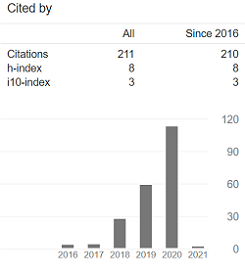Perbedaan Physical Self-Concept dan Aktivitas Fisik Usia Remaja: Apakah Ada Hubungannya?
Sari
Tujuan penelitian ini mengkaji keterkaitan antara physical self-concept dengan aktivitas fisik pada usia remaja. Metode penelitian yang digunakan adalah asosiasonal korelasi dan kausal komparatif. Partisipan dalam penelitian adalah 50 orang siswa Sekolah Menengah Atas (SMA) yang ada di pedesaan Jawa Barat. Instrument Personal Self-Description Questionnaire (PSDQ) digunakan untuk mengukur physical self-concept, sedangkan Accelerometer (ActivPAL) digunakan untuk mengukur aktivitas fisik. Hasil penelitian menunjukkan bahwa tidak ada hubungan yang signifikan antara physical self-concept dengan aktivitas fisik pada usia remaja SMA p > 0.05. Temuan ini berbeda dengan beberapa hasil penelitian sebelumnya dan perlu dikaji lebih jauh lagi.
Kata Kunci
Teks Lengkap:
PDF (English)Referensi
American Academy of Pediatrics. Committee on Public Education, C. on P. (2001). American Academy of Pediatrics: Children, adolescents, and television. Pediatrics. https://doi.org/10.1542/PEDS.107.2.423
Bauman, A., Bellew, B., Vita, P., Brown, W., & Owen, N. (2002). Getting Australia active: toward better practice for the promotion of physical activity. Retrieved from http://www.health.vic.gov.au/archive/archive2014/nphp/publications/sigpah/gaa.pdf
Craven, R. G., & Marsh, H. W. (2008). The centrality of the self-concept construct for psychological wellbeing and unlocking human potential : Implications for child and educational psychologists. Educational & Child Psychology, 25(2), 104–118. https://doi.org/10.1111/1467-8624.00421
Daniels, D. (2000). Business management - Emerging marketplace demands printers put emphasis on employees’ motivational drives. Instant and Small Commercial Printer, 19(6), 40. https://doi.org/10.3102/00346543046003407
Department of Health. (2004). At Least Five a Week- Evidence on the impact of physcal activity and its relationship to health. Department of Health. https://doi.org/10.1111/j.1467-3010.2004.00455.x
Department of Health and Ageing. (2004). Active kids are healthy kids. Australia’s Physical Activity Recommendations for 5-12 year olds. Commonwealth of Australia.
Gónzalez Fernández, O. (2011). La presión sociocultural percibida sobre el autoconcepto físico: naturaleza, medida y variabilidad. Servicio Editorial de la Universidad del País Vasco. Retrieved from http://www.ehu.es/argitalpenak/images/stories/tesis/Ciencias_Sociales/GONZALEZ FERNANDEZ OSCAR.pdf%5Cnhttp://www.psikor.es/images/docs/tesis/la-presion-sociocultural-percibida-sobre-el-autoconcepto-fisico-naturaleza-medida-y-variabilidad.pdf
Lifestyles Statistics Team. (2015). Statistics on Obesity, Physical Activity and Diet: England 2015. Health and Social Care Information Centre. https://doi.org/http://www.ic.nhs.uk/pubs/alcohol09
Seefeldt, V., Malina, R. M., & Clark, M. A. (2002). Factors affecting levels of physical activity in adults. Sports Medicine. https://doi.org/10.2165/00007256-200232030-00001
U.S. Department Of Health And Human Services. (1996a). Physical Activity and Health: A Report of the Surgeon General. National Center for Chronic Disease Prevention and Health Promotion. https://doi.org/10.1080/01635580903441295
U.S. Department Of Health And Human Services. (1996b). Physical Activity and Health: A Report of the Surgeon General. U.S. Department of Health and Human Services, Centers for Disease Control and Prevention, National Center for Chronic Disease Prevention and Health Promotion. https://doi.org/10.1080/01635580903441295
DOI: https://doi.org/10.17509/jtikor.v4i2.18873
Refbacks
- Saat ini tidak ada refbacks.
##submission.copyrightStatement##
##submission.license.cc.by-nc-sa4.footer##







